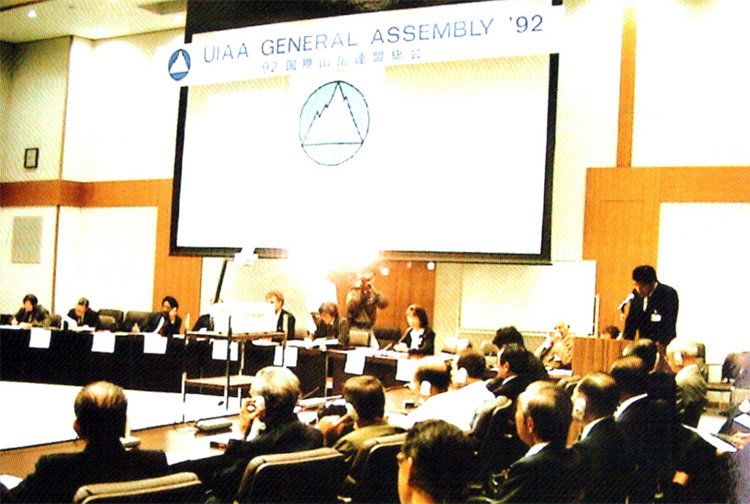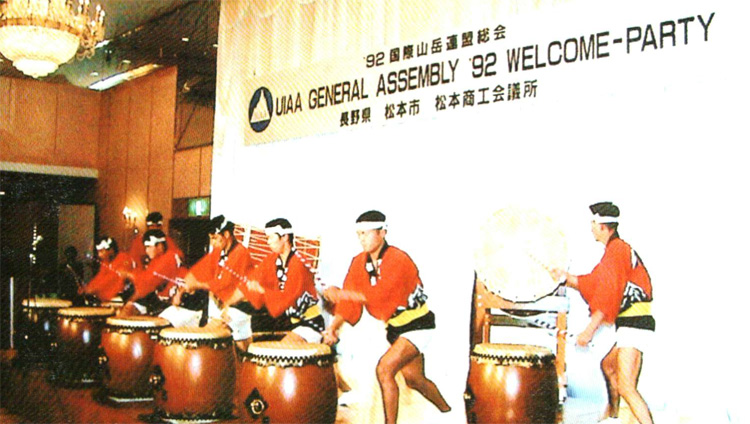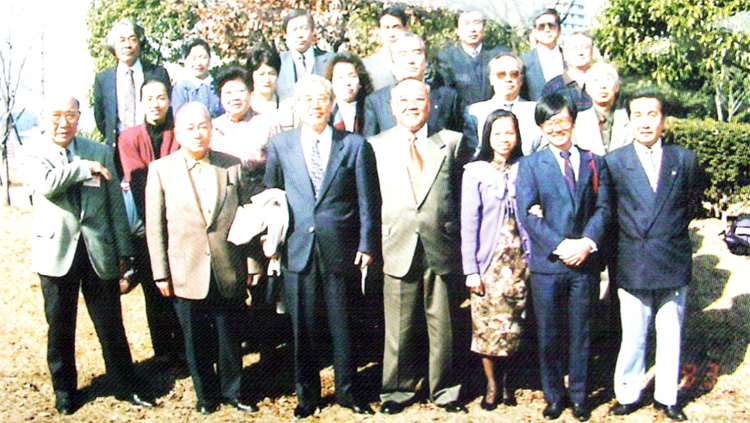History
Formation of Union of Asian Alpine Associations

UIAA Matsumoto General Assembly. UAAA was conceptualised by the members who attended this meeting from the asian federations. Asian members proposed JMA to take the instative for UA's establishment.
History
Since UIAA founded in 1932. UIAA had been instrumental to play a role of inspiration within the member associations and respective countries in forming expedition teams with the aim of climbing highest peaks of the Himalaya and the Karakoram ranges.
The UIAA was formed as a platform for cultural exchange and strengthening friendship among alpinist and mountaineers through bringing all the alpinism associations under one umbrella. Its basic objectives were to disseminate climbing skills, encouraging safe climbing, establishment of mountain rescue body, protecting the environment and introducing competitive climbing etc. As of April 2006, it has 90 organizations as members in 65 countries.
A general assembly was held on October 1982 in Kathmandu to commemorate 35 years of the establishment of UIAA. It concluded with the Kathmandu Declaration that focussed on mountain environment protection which is considered as a gospel for mountain peoples and the those who deal with mountain region in one way or the other. Since then the mountain environment protection issue has gained momentum all over the world.
In the 1990s, sport climbing competitions have became popular. Many countries held world cup and other championships in order to and with an objective of participating in the future Olympic Games. Sport climbing has become very popular among the young people in Asia: more than 20 organizations have joined the UAAA. At the moment, the authentic mountaineering and sport climbing are considered two equally important aspects within UIAA and UAAA structure.
Progress of the general meeting at Matsumoto
UIAA was working to include sport climbing as one of the Olympic events. The prerequisite set by Olympic Committee was to hold 50 world cup sport climbing competition before it got the endorsement for inclusion. But it did not gaint he required momentum until the General Assembly in Matsumoto. This general meeting endorsed and extended its support to hold the world class climbing competition in a more competition like and more organized way in Asia and all over the world. This was felt and decided in the light of fewer number of such competitions held in the past is Asia. South America and Africa, however, this kind of competition were gaining much popularity in North America and European countries.
Among 17 committee members in UIAA, Japan was the only member where until then none of the UIAA General Meeting was held. Therefore, at the General Assembly held in Holland in 1990. A proposal to that effect was presented by American Alpine Club and seconded by Indian Mountaineering Foundation. This proposal was overwhelmingly adopted by the Assembly. Friends of UIAA had a very high expectation that JMA could handle it very smoothly and professionally.
But back in Japan, JMA was not really prepared for it. It seemed daunting task because unlike other countries there was no government support to this kind of big international conference. All the economic, managerial and organizational burdens were on the shoulders of the then JMA officials. Along with these difficulties, language barrier was on of the challenges in communication the whole process. However, with the support of JMA officials and members it all went well. Nowadays, many Japanese cities have convention centers and international conference have become regular features.
On the request of JMA, Matsumoto, the gateway city to Kamikochi Alps Region, made a generous offer to hold this UIAA General Assembly in October 1992, a year after the Hungary UIAA General Assembly in 1991.
The UIAA General Meeting at Matsumoto
The UIAA general meeting was held in Matsumoto from 9th to 11th of October in 1992 with 100 member organizations from 35 countries participating. It was 10 years after the Kathmandu Declaration on mountain environment protection and the environment issue was the main theme and there were extensive discussions about the means and ways to promote sport climbing as an Olympic event.
On the above context, a world cup climbing competition was held in Tokyo in 1991 with 70 participants from around the world plus 30 Japanese with a total of 100 participants. After general meeting in Matsumoto in 1992, Kobe city hosted another world cup climbing competition which gave a boost for the promotion of sport climbing in Asia.

UIAA Matsumoto General Assembly.The cultural group welcoming the UIAA deligates by the beats of traditional Japanese drum
Movement to form Asian Mountaineering Union
The 2 day general meeting was held as scheduled at the Matsumoto cultural center conference room. In between the conference events, Asian delegates talked with Japan about the need to form an Asian Mountaineering Union. Even though there were strong requests from Asian countries to form the Asian Mountaineering Association, the Japan Mountaineering Association was not keen on the idea as JMA regarded the communication within UIAA as sufficient for Asian countries and did not want to increase the communication pressure any further.
At that time, the UIAA had the system reform committee to consider the way for UIAA, how to operate and plan future operations. Japan was one of committee members and had asked for the UIAA general meeting to be held every 2 or 3 years to reduce meeting expenses of the Asian delegates. We suggested for having a separate continental or regional meeting for Asia, Africa, South America. North America and Oceania etc. prior to the next UIAA general meeting. But this proposal of JMA on behalf of Asian countries and others was ignored. After this incident JMA also went in favour of establishing Asian Mountaineering Union.
At this stage, JMA was quite serious about it. But initially there was a big wall standing between JMA officials and the JMA international section in understanding the pressure put by other Asian countries to form UAAA. This resulted in having a meeting called the Asian Mountaineering Conference in Tama Center, Tokyo to keep international relations despite JMA being hesitant. This meeting was for the individual mountain climbers, though there was very strong pressure to form UAAA, We had to promise to form UAAA in Japan at the next meeting.

UIAA Asian Meeting TAMA 1993
After the brain storming meeting in Matsumoto in 1992 in between the GA, a further extensive meeting was held in Tokyo, Tama center which came up with a resolution to establish UAAA with greater participation from among the Asian Alpine Associations. It decided to call a Founding Preliminary General Assembly in Tama Center, Tokyo in 1993 which adopted a UAAA founding charter subject to further amendment in its first general meeting the following year. In favour of establishing UAAA, delegates from Korea, Pakistan, China, Hongkong, Taiwan and Nepal actively participated in the deliberation. The main point raised by all the delegates present was that UIAA was more Europe centered, voice of Asian members were ignored, the need to address the issues on mountain protection, environment, youth activities and skill development in this region were overlooked by the UIAA. Hence, a strong need was felt to address those issues among themselves by forming UAAA as a common platform for the Asians but without confronting or offending UIAA but rather working harmoniously with UIAA in the capacity of its sister organization.
As Japan hosted the UIAA general meeting at Matsumoto and twice hosted the Asian Mountaineering Conference. Japan could not say no to the UAAA establishment. All the Asian countries wishing to form UAAA were strong on their point, therefore, JMA found itself at the crossroad of making decision. JMA operators could feel the atmosphere and some change in JMA had started in the area of international understanding, trust and communication. We believed that there was no alternative but host the next UAAA conference in Japan. But it was a matter of great relief that invitation arrived from the KAF of Korean for a general meeting of UAAA.
The UAAA Seoul General Meeting
KAF called a meeting on November 4, 1994 in Seoul to adopt the Tama center resolutions made by the first preliminary general assembly of UAAA in 1993.
Korea said Japan had already hosted the meeting twice, therefore it was the turn of Korea to be the host. Even if the meeting was held in Korea, Asian countries requested Japanese leadership. Every country had its own reason not to be the leader country and requested the president from JMA. Korea had CAC and KAF and it was not possible for one of them to be the president. Korean CAC was a board member of UIAA and KAF wanted to promote UIAA activities in Korea and wished to be a vice president of UAAA. The main agenda was to decide the persons in charge and regulations including membership fees. The name was similar to UIAA(Union International D'Alpinisme Association) just changed international to Asian. The UAAA.
The annual fee was fixed at US$1,000 per annum per member organization. Japan requested China to be the president, but China accepted to be the vice president because of the domestic situation and climbing history. China proposed JMA president Mr. Saito to be the president and was agreed by all. Mr. Saito became the first president of UAAA. We had a trouble to decide the second vice president, Pakistan, Taiwan and Hong Kong declined the position. We would hve linked to nominate Iran, Nepal and India but Nepal did not accept while the delegates from Iran and India were not present at the meeting. Some groups wanted to get involved. It was hard to choose the second vice president. We wanted the Korean KAF to be the vice president and we thought he would accept. We had a coffee break to change the atmosphere and then KAF called Tadao Kanzaki, the speaker to discuss about the proposition and accepted the position fo vice president. The speaker must conduct the meeting equally and at the same time the speaker must arrange for progress and talked to the Korean CAC. CAC was happy to nominate KAF as long as other countries were satisfied. The speaker announced the KAF president as the vice president of UAAA and finally Japan, China and Korea became the president and vice presidents of UAAA respectively. Korean KAF suggested the annual fee of US$1,000 and a joining fee of US$1,000 and everybody consented. A concrete decision was made with the name of UAAA, the officials, the board members and the fee, and thus, UAAA was finally set to its journey ahead.